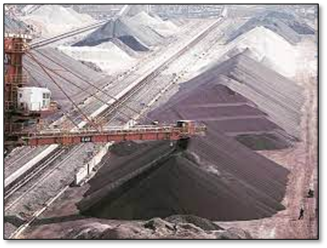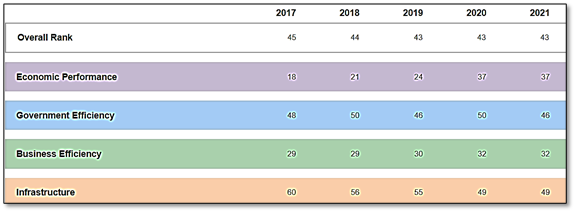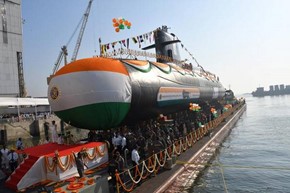Tuesday, 22nd June 2021
The GAR Special Report on Drought 2021
In News
The Global Assessment Report (GAR) Special Report on Drought 2021 is released by the UN Office for Disaster Risk Reduction (UNDRR).
Key Highlights of the Report
- Droughts are recurrent events that affect large areas around the world each year. Their lengths are highly variable, from a few weeks to several years. They are challenging to define, characterize and manage due to their slow onsets (in most cases) and indeterminate ends.
- Drought is not aridity or water scarcity. The drought hazard is a failure of whatever system drives the hydrological balance. This can include reduced rainfall, inadequate timing or ineffectiveness of precipitation etc.
- Drought conditions arise from changes in atmospheric conditions. El Niño Southern Oscillation, the Pacific Decadal Oscillation and the Interdecadal Pacific Oscillation are key indicators of changes in atmospheric conditions associated with drought conditions across the world.
- Understanding the mechanisms of such climate features is key to improving capabilities for a timely seasonal prediction of drought events.
- Drought has directly affected 1.5 billion people from 1998 to 2017, more than any other slow-onset disaster. This also led to economic losses of at least $124 billion across the world. E.g., annual losses in the USA of approximately $6.4 billion, and €9 billion in the European Union.
- Climate change is an increasing driver of drought generation and is intensifying drought impacts, increasing the frequency, severity and duration in many regions of the world.
- Drought is one of the drivers of desertification and land degradation, thus increasing fragility of ecosystems and social instability, especially in rural communities.
- Drought hazard and human activities (e.g., land and water management) are strongly intertwined, such that these activities can exacerbate the drought hazard and increase the risk of severe socioeconomic and ecological impacts.
- In recent decades, several drought hotspots (areas particularly often or severely affected) have been identified as: The Mediterranean region, Southern Australia, Sub-Saharan Africa, Southern South America, South-western USA, North-eastern Brazil.
India-specific findings
- The impact of severe droughts on India’s GDP is about 2-5% per annum across sectors. For instance, in recent major droughts in Tamil Nadu, a 20% reduction in the primary sector caused an overall 5% drop in industry and a 3% reduction in the service sector.
- The Deccan region sees the highest frequency (of more than 6%) of severe droughts in all of India.
- The report found “significant drought conditions” once in every three years in the Deccan Plateau leading to large scale migration and desertification.
Key recommendations
- Prevention has far lower human, financial and environmental costs than reaction and response.
- A mechanism for drought management at the international and national levels could help address the complex and cascading nature of drought risk.
- Financial systems and services need to evolve to encourage cooperative approaches, to promote social protection mechanisms and to encourage risk transfer and contingent financing, so as to provide diversified adaptive support to drought risk management.
https://www.undrr.org/event/launch-gar-drought-2021
https://www.undrr.org/publication/gar-special-report-drought-2021
Draft e-commerce policy norms
In News
Government has issued draft e-commerce policy note.
About the News
To protect the interests of consumers and encourage free and fair competition in the market, Government has proposed the draft of the proposed amendments to the Consumer Protection (E-commerce) Rules, 2020. The Consumer Protection (E-Commerce) Rules, 2020 were first notified in July 2020. Their violations attract penal action under the Consumer Protection Act, 2019.
Sources: https://pib.gov.in/PressReleasePage.aspx?PRID=1729201
World Investment Report 2021
In News
India received $64 billion in foreign direct investment (FDI) in 2020, the fifth largest recipient of inflows in the world, according to the World Investment Report 2021 by the UN Conference on Trade and Development (UNCTAD)
Global FDI Status
- Global FDI flows: As per the report, global FDI flows have been severely hit by the pandemic and they plunged by 35 per cent in 2020 to $1 trillion from $1.5 trillion the previous year. Lockdowns slowed down existing investment projects.
- Digital Boom: The pandemic boosted demand for digital infrastructure and services globally. This led to higher values of Greenfield FDI project announcements targeting the ICT industry, rising by more than 22 per cent.
- Asia’s Impact: A wider resurgence of the virus in Asia could significantly lower global FDI in 2021. The FDI inflows in Asia are expected to increase in 2021, outperforming other developing regions with a projected growth of 5–10 per cent.
- Asia is the only region to record growth and increasing Asia’s share of global inflows to 54 per cent. While some of the largest economies in developing Asia such as China and India recorded FDI growth in 2020, the rest recorded a contraction.
India’s FDI Status
- FDI Trends: In India, FDI increased 27 per cent in 2020, pushed up by acquisitions in the information and communication technology (ICT) industry, making the country the fifth largest FDI recipient in the world. India ranked 18 out of the world’s top 20 economies for FDI outflows.
- Contraction: Announced Greenfield projects in India contracted by 19 per cent in 2020 and the second wave can lead to a larger contraction in 2021.
- Boost by PLI scheme: India’s Production Linkage Incentive (PLI) scheme, designed to attract manufacturing and export-oriented investments in priority industries including automotive and electronics can drive a rebound of investment in manufacturing.
About Foreign Direct Investment
Foreign direct investment (FDI) is when a company takes controlling ownership in a business entity in another country. With FDI, foreign companies are directly involved with day-to-day operations in the other country. This means they are not just bringing money with them, but also knowledge, skills and technology.
Image Source: https://unctad.org/news/global-foreign-direct-investment-set-partially-recover-2021-uncertainty-remains
Global Trade and Marine Pollution
In News
Recently a cargo ship X-Press Pearl, carrying hazardous chemicals, including nitric acid, caught fire, exploded, and later sank off the coast of Colombo, Sri Lanka.
About the News
- The nitric acid leak on the ship caused the fire. The corrosive chemicals on the ship will cause acidity of ocean water and hasten bleaching of corals. It is touted as Sri Lanka’s worst environmental disaster.
- The plastic pellets that spilled into the Indian Ocean following the fire have resulted in hundreds of dead marine animals washing up on the beaches of Sri Lanka along with heaps of plastic. The plastic pellets, which have washed off into the ocean, are also likely to come to the coasts of India, Maldives, Indonesia, among others.
Maritime transport and Global Trade
- Maritime transport is the backbone of international trade and the global economy. Around 80 per cent of global trade by volume and over 70 per cent of global trade by value are carried by sea and are handled by ports worldwide.
- Developing economies account for the largest share of global seaborne trade, both in terms of exports and imports.
How is Global Trade causing Marine Pollution?
- Oil Spills: While the transport of oil is responsible for only 12% of all oil spills worldwide, about two-thirds of those are from marine vessels. The operation of ships' power plants also results in spills of lubricating oil, fuel oil, grease, and water into bilges. Severity of oil spills on marine organisms depends on the type of oil, exposure pathway, and degree of weathering.
- Dry Bulk Cargo Release: Five major bulk commodities (iron ore, coal, grain, bauxite, and phosphate rock) account for ~ 57% of the total volume of all global transported dry bulk commodities. Releases of dry bulk material into the marine environment occur via accidental releases (e.g., sinkings and ship losses), and operational releases (dumping or discharging of cargo residues after washing of cargo holds).
- Ballast-water discharged from ships at ports: The transfer of ballast water into the sea increases risks of introduction of aquatic invasive species (AIS) following discharge of untreated ships’ ballast water, representing major threats to global biodiversity.
- Sound pollution: Underwater Ocean ambient noise levels have increased by ~ 15 dB in the past 50 years due to increased marine transportation, resource extraction, fishing, recreational activities, and other anthropogenic sources. Sound travels approximately five times faster in water than air and the wide range of detrimental effects to marine species.
- End of Life Ship Disposal: The process of ship breaking can negatively impact both environmental and human health. Main sources of pollution arising from shipbreaking activities include fumes, noise and vibration from welding and cutting, flammable substances, metal etc.
- Port Building: The location of a port affects aquatic fauna and flora through changes of water quality, coastal hydrology, and bottom contamination. Land reclamation from the sea destroys bottom habitat and displaces fishery resources. Terrestrial fauna and flora may also be altered by the location of a port.
Effect of Pollution on Marine Ecosystem
- Effect of Plastic Pollution: With 1.15–2.41 million tonnes of plastic entering the ocean each year, plastic pollution is estimated to reduce marine ecosystem services by 1–5 per cent. Microplastics often get caught in the gills of marine animals, suffocating, and killing them.
- Dead zones: Over the last 50 years, the open ocean has lost 77 billion metric tonnes of oxygen, expanding ‘dead zones’ by 4.5 million km2 – similar in size to the European Union. Toxins along with garbage deplete the oxygen content of the water, causing hypoxia in marine fauna.
- Eutrophication: Excessive inputs of nutrients into water bodies are primary cause of eutrophication. It can result in an increase in the ecosystem's primary productivity (excessive plant growth and decay) and leads to lack of oxygen in the water.
- Acidification: Rising water temperatures and acidification (caused by rising CO2 levels) are affecting the productivity and the distribution of marine fish stocks. If left unabated, coral reefs are expected to disappear due to bleaching and acidification by the end of this century.
- Oil Pollution: Oil pollution also results in disruptions to the cycle of coral reefs, clogging of the gills of fishes thereby resulting in their death and hampering the process of photosynthesis of marine plants leading to their end.
- Fishing Industry: The fishing industry suffers because the fish are often covered in oil or have swallowed oil making them poisonous. Also, a large number of fish die. The local economies of coastal towns that depend on these industries can be devastated.
- Tourism Industry: Tourism suffers in beach communities that are overcome by pollutants in the ocean. For example, if spilled oil reaches the shore, it contaminates the inter-tidal zone and the beaches. The local tourist industry suffers as aesthetic beauty of seashore is lost due to oil slick. Industries that rely on clean seawater for routine operations can also suffer.
Way Forward
- International Convention for the Prevention of Pollution from Ships (MARPOL): MARPOL is the main international convention to prevent marine pollution by ships from operational or accidental causes. Additionally, the International Maritime Organization (IMO) uses various instruments to protect the marine environment from shipping activities.
- Technological Solutions: Although the shipping industry has access to some advanced technologies zero-emission vessels (e.g., ultra-slow moving, on-board energy conversion, and ballast-free, composite hull) and alternative marine fuels (e.g., LNG and methanol), it needs to be further investigated to ease the stress on the marine environment from transportation.
- Regional and National Initiative: The Maritime Zones of India Act 1976, enables the Government to take measures for protection of the marine environment. The Coast Guard Act 1978 states that the preservation and protection of marine environment and control of marine pollution is the function of the Indian Coast Guard.
Question: Examine the impact of global trade on marine pollution. Suggest remedial measures.
https://europe.oceana.org/en/shipping-pollution-1
Secondary Sources: https://arcb.com/blog/major-shipping-routes-for-global-trade
https://stats.unctad.org/handbook/MaritimeTransport/WorldSeaborneTrade.html
This Day in History Charon: Pluto’s moon
On June 22, 1978, the largest of Pluto's five moons, Charon, was discovered at the U.S. Naval Observatory. At half the size of Pluto, Charon is the largest known satellite relative to its parent body. Pluto-Charon is our solar system's only known double planetary system. The same surfaces of Charon and Pluto always face each other, a phenomenon called mutual tidal locking.
Sources: https://solarsystem.nasa.gov/moons/pluto-moons/charon/in-depth/
Image of the Day- Harit Marubhumi Campaign
100 women in each of the 33 village panchayats of Taranagar block in Rajasthan's Churu district planted 5,100 saplings simultaneously earlier this week to mark the World Day to Combat Desertification and Drought. The women pledged to treat the plants as “green members” of their families as part of a unique Harit Marubhumi (green desert) campaign. The campaign highlights the crucial interconnection between humanity and nature, making the tree an inseparable part of the “family consciousness”. The moving force behind the campaign, Shyam Sunder Jyani, recipient of this year's Land for Life Award of the U.N., guided the volunteers in preparing the soil, selecting the saplings, and planting them with care. Dr. Jyani's concept of institutional forest has executed sustainable forest management in educational institutions.
NISHTHA
- Context: Ministry of Tribal Affairs and NCERT have come together on a joint mission for NISHTHA Capacity Building Programme for Eklavya Model Residential Schools (EMRS) Teachers and Principals.
- NISHTHA- National Initiative for School Heads’ and Teachers’ Holistic Advancement Program, was launched by the Department of School Education and Literacy, Ministry of HRD (now Ministry of Education) to improve learning outcomes at the Elementary level through Integrated Teacher Training in 2019.
- It is a national flagship program of NCERT and is the largest teachers’ training programme of its kind in the world working under the centrally sponsored scheme of Samagra Shiksha.
- It is a capacity building program that aims to build competencies among teachers and school principals to foster critical thinking in students, handle diverse situations and act as first level counsellors.
Primary source: https://pib.gov.in/PressReleasePage.aspx?PRID=1591969
https://www.pib.gov.in/PressReleasePage.aspx?PRID=1728867
Summer solstice
- Context: The longest day of 2021 for those living north of the Equator is June 21- technically referred to as the summer solstice.
- It occurs when the sun is directly over the Tropic of Cancer, or more specifically right over 23.5-degree north latitude.
- It is the longest day and shortest night of the year in the Northern Hemisphere.
- During the solstice, theEarth’s axis -around which the planet spins, completing one turn each day is tilted in a way that the North Pole is tipped towards the sun and the South Pole is away from it.
- The Sun never sets during the summer solstice at the Arctic Circle.
Picture source: https://www.kxan.com/weather/weather-blog/winter-is-officially-here/
Black Softshell Turtle
- Context: A major temple in Assam has signed a MoU with two NGOs, for long-term conservation of the rare freshwater black softshell turtle (Nilssonia nigricans).
- The black softshell turtle is a freshwater species which looks similar to the Indian peacock softshell turtle (Nilssonia hurum), which is classified as vulnerable in the IUCN Red List.
- They are found in ponds of temples in northeastern India and Bangladesh. Its distribution range includes river Brahmaputra River and its tributaries.
- The International Union for Conservation of Nature had in 2021 listed the turtle as ‘critically endangered’ and is protected under Appendix I of CITES.
Primary source: https://india.mongabay.com/2020/05/moved-from-temple-ponds-to-the-wild-black-softshell-turtles-walk-towards-revival/
Picture source: https://www.thehindu.com/news/national/other-states/vision-document-for-conserving-assam-temple-turtles-launched/article34863208.ece
Section 27A of NDPS Act, 1985
- Context: The Tripura High Court, in a significant verdict, discovered an oversight in drafting the 2014 amendments to the Narcotics Drugs and Psychotropic Substances Act, 1985.
- The NDPS Act, 1985 is the principal legislation through which the state regulates the operations of narcotic drugs and psychotropic substances.
- It provides a stringent framework for punishing offenses related to illicit traffic in narcotic drugs and psychotropic substances through imprisonments and forfeiture of property.
- Section 27A of the NDPS Act, 1985, prescribes the punishment for financing illicit traffic and harboring offenders.
Primary source: https://indianexpress.com/article/explained/explained-how-a-drafting-oversight-has-made-the-ndps-act-toothless-in-a-key-provision-7366695/
Picture source: https://www.newindianexpress.com/nation/2020/oct/14/bollywood-drugs-case-ncb-opposes-kshitij-prasads-bail-plea-2210232.html
Understanding Pakistan’s Kashmir conundrum
Essence: Mr C. Rajamohan is explaining various developments & perspectives on Kashmir tussle between India & Pakistan, in a simply organised chronology. In the last few years, Prime Minister Modi has tried to restructure India’s Pakistan policy, including on Kashmir. In breaking from the endless cycle of talks-terror-talks, Modi was eager to gain the initiative in the complex diplomatic/political/military dynamic with Pakistan. We also have some positive indications like Pakistan’s army chief calling for a reorientation of Pakistan’s national strategy away from “geopolitics” to “geoeconomics”, and underlined the importance of good neighbourly relations with Afghanistan and India. However, Imran’s reversal on importing of sugar and cotton, suggested significant internal differences within Pakistan on engaging India, especially on the question of Kashmir.
Why you should read this article?
- To know about the Pakistan’s strategic dilemma, post Kashmir’s special status abrogation.
- To gain insights into India’s present posturing in International forum’s on Kashmir issue.
- To know about the changing trajectory of India’s Pakistan policy & underlying reasons.
Article Link: https://indianexpress.com/article/opinion/columns/jammu-kashmir-leaders-pm-modi-meet-pakistan-india-relations-7369545/
Towards a more federal structure
Essence: Preserving the unity of India was a great concern at the time of independence. It was natural that India opted to be a Union where the Central government has more authority and power. This article brings out the present nature of fiscal relations between Union and States and makes a case for greater economic power to the States so that they can directly collect more taxes and be less dependent on the Central government.
Why you should read this article?
- Know about the nature of revenue distribution between Centre and States.
- Understand that a more federal structure with greater economic power to the States, will allow the Centre to focus on external threats instead of internal dissensions.
Tags- Federal, Paper 2, Governance
Article Link: https://www.thehindu.com/opinion/op-ed/towards-a-more-federal-structure/article34893800.ece
The Team Which Has Created More Than 10,000 Affordable Computers From Scrap!
Background:
- We all are slaves of technology and replace the gadgets as soon as it becomes outdated or when we are bored without even thinking of its consequence on the environment.
- On the other hand, thousands of people cannot afford to purchase the gadgets.
Affordable Gadgets:
- Moved by this discrepancy, a young entrepreneur, Mukund BS got an idea to collect the scrap computers from corporates and sells them at affordable rates to the needy people after the required repair and maintenance.
- As against the process of buying the computers from the corporates, which takes as long as six months, the process of repairing a scrap computer takes around 2-3 weeks.
Outcome:
- Using this method, the organization has sold 10,000 computers so far in a span of five years.
- Start-ups have started taking innovative step towards circular economy
Things to ponder:
- Circular economy, Wealth from waster, innovation, role of start-ups in the economy of India.
Article Link: https://www.thebetterindia.com/10475/ones-scrap-someones-treasure-renew-converted-scrap-computers/
Share the article
Get Latest Updates on Offers, Event dates, and free Mentorship sessions.

Get in touch with our Expert Academic Counsellors 👋
FAQs
UPSC Daily Current Affairs focuses on learning current events on a daily basis. An aspirant needs to study regular and updated information about current events, news, and relevant topics that are important for UPSC aspirants. It covers national and international affairs, government policies, socio-economic issues, science and technology advancements, and more.
UPSC Daily Current Affairs provides aspirants with a concise and comprehensive overview of the latest happenings and developments across various fields. It helps aspirants stay updated with current affairs and provides them with valuable insights and analysis, which are essential for answering questions in the UPSC examinations. It enhances their knowledge, analytical skills, and ability to connect current affairs with the UPSC syllabus.
UPSC Daily Current Affairs covers a wide range of topics, including politics, economics, science and technology, environment, social issues, governance, international relations, and more. It offers news summaries, in-depth analyses, editorials, opinion pieces, and relevant study materials. It also provides practice questions and quizzes to help aspirants test their understanding of current affairs.
Edukemy's UPSC Daily Current Affairs can be accessed through:
- UPSC Daily Current Affairs can be accessed through Current Affairs tab at the top of the Main Page of Edukemy.
- Edukemy Mobile app: The Daily Current Affairs can also be access through Edukemy Mobile App.
- Social media: Follow Edukemy’s official social media accounts or pages that provide UPSC Daily Current Affairs updates, including Facebook, Twitter, or Telegram channels.





